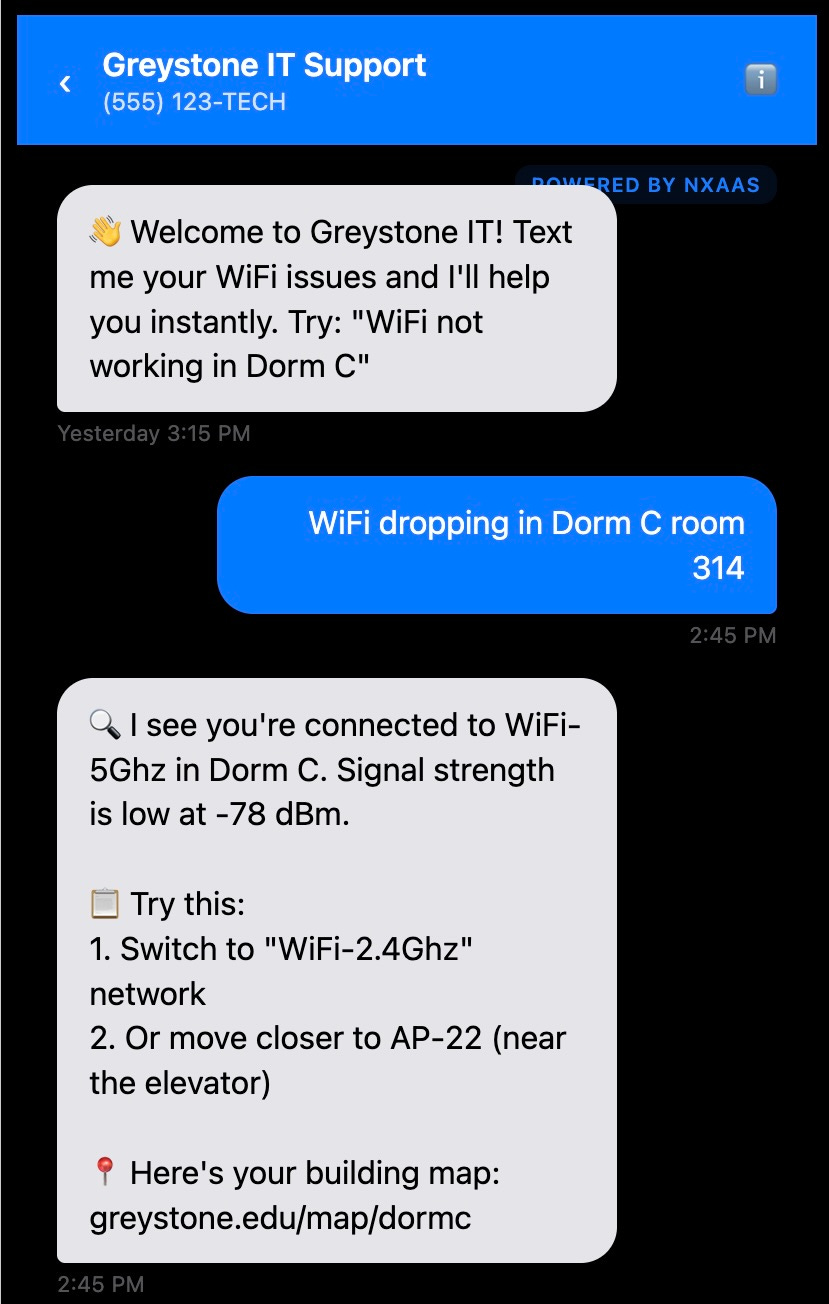NXaaS In Action: University IT Helps Students Via SMS
Part 2 of our NXaaS series exploring real-world implementations
Move-in weekend at any university is controlled chaos. Thousands of students arrive on campus simultaneously, all trying to connect their devices to WiFi, download apps, and get their digital lives set up in their new dorms. For campus IT teams, it's the most dreaded weekend of the year.
At Greystone University, the pattern was predictable and painful: by Sunday evening of move-in weekend, the IT helpdesk would be drowning in support tickets. "Can't connect in Dorm C." "WiFi won't stay connected in lecture hall." "Random dropouts near the science building." Each ticket required manual investigation, site visits, and often hours of back-and-forth troubleshooting.
The problem wasn't just volume—it was context. When a student reported "WiFi not working," the IT team had to play detective: Which device? Which access point? What's the signal strength? Are other students in the area having similar issues? By the time they gathered this information, frustrated students had often given up or found workarounds that created new problems.
The SMS Solution
This year, Greystone deployed NXaaS with a simple but powerful interface: SMS-based IT support. Students can now text the university's IT number and get instant, contextual help.
Here's how a typical interaction works:
Student texts: "WiFi dropping in Dorm C room 314"
NXaaS responds: "I see you're connected to WiFi-5Ghz in Dorm C. Signal strength is low at -78 dBm. Try switching to WiFi-2.4Ghz, or move closer to AP-22. Here's a map:"
Behind this seemingly simple exchange, NXaaS is orchestrating multiple API calls:
Authentication APIs identify the student and their registered devices
WiFi APIs pull real-time connection data and signal strength metrics
LAN APIs provide network topology and access point information
Device status APIs check for compatibility issues or configuration problems
Location APIs correlate the student's position with nearby infrastructure
The AI doesn't just aggregate this data—it translates technical network diagnostics into actionable advice that students can actually follow.
Beyond Basic Troubleshooting
The system gets smarter with each interaction. When multiple students report issues in the same area, NXaaS can identify infrastructure problems before they become widespread outages. It can also provide predictive guidance:
Student: "Moving to the library, will WiFi work there?"
NXaaS: "Library WiFi is optimal. Your device connects best to 5Ghz networks. AP-15 near the main entrance has the strongest signal for your location."
For campus IT teams, this creates a feedback loop of continuous improvement. Instead of reactive ticket resolution, they get real-time visibility into network performance from the user perspective.
The Technical Architecture
The NXaaS implementation at Greystone integrates with the university's existing network infrastructure through a series of API endpoints:
Network APIs provide real-time data about access points, signal strength, bandwidth utilization, and connection quality across the campus. The system can identify whether connectivity issues stem from device configuration, network congestion, or infrastructure problems.
Authentication systems securely link students to their registered devices while maintaining privacy. The system knows which devices belong to each student without storing personal data beyond what's necessary for troubleshooting.
Location services correlate approximate user positions with network topology, enabling location-specific recommendations without requiring precise GPS tracking.
The AI component serves as an intelligent interpreter, transforming raw network telemetry into conversational guidance that makes sense to non-technical users.
Results That Matter
The transformation has been dramatic. Before NXaaS:
Average ticket resolution time: 4.2 hours
Move-in weekend tickets: 1,847 over three days
Student satisfaction scores: 2.3/5 for IT support
With NXaaS deployed:
Average response time: 18 seconds
Tickets requiring human intervention: Down 73%
Student satisfaction scores: 4.6/5 for IT support
Perhaps most importantly, IT staff can focus on proactive network improvements instead of firefighting connectivity issues.
Lessons for Campus IT
Greystone's success with NXaaS highlights several key principles for modern campus IT:
Meet students where they are. SMS works because it's universal—every student has texting, regardless of their device or platform preferences.
Context is everything. Generic troubleshooting steps frustrate users. Specific, situational guidance based on real network data creates successful outcomes.
AI amplifies expertise, not replaces it. The system doesn't eliminate the need for skilled IT professionals—it frees them to work on higher-value challenges while ensuring students get immediate help for common issues.
Data drives decisions. By aggregating thousands of support interactions, NXaaS provides unprecedented visibility into how students actually use campus networks, informing infrastructure investments and policy decisions.
What's Next
This is just the beginning for NXaaS in education. Future implementations will expand beyond WiFi troubleshooting to include printer connectivity, application access issues, and even integration with learning management systems. The goal remains the same: using AI to make complex technical systems more accessible to the humans who depend on them.
NXaaS (Network-Experience-as-a-Service) transforms complex network infrastructure into conversational interfaces that anyone can understand. Learn more about implementing NXaaS in your organization at buglabs.net.



